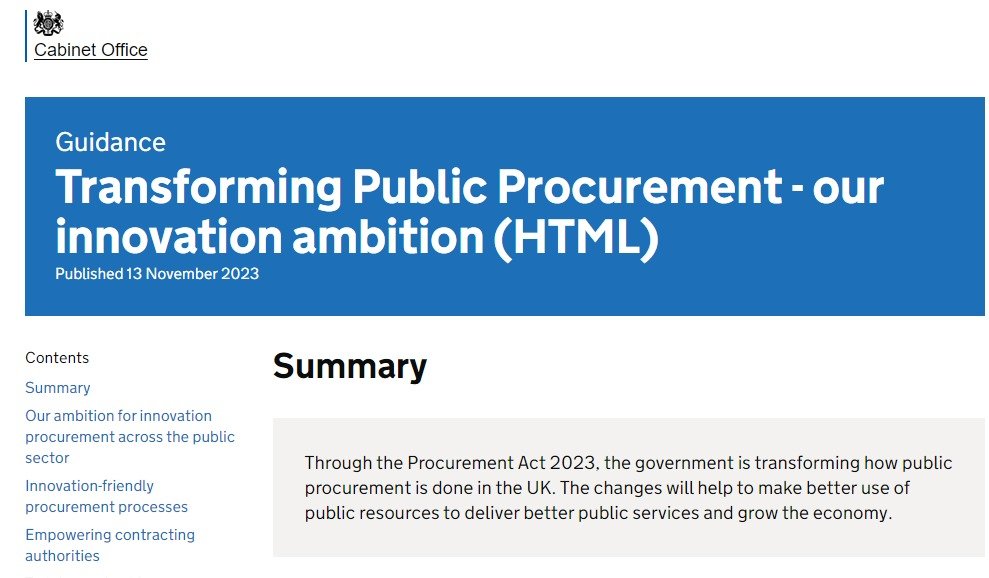On 13 November 2023, the UK Government published guidance setting out its ambitions for innovation procurement under the new Procurement Act 2023 (not yet in force, of which you can read a summary here). This further expands on the ambitions underpinning the Transforming Public Procurement project that started after Brexit. The Government’s expectation is that the ‘the new legislation will allow public procurement to be done in more flexible and innovative ways’, and that this will ‘enable public sector organisations to embrace innovation more’.
The innovation procurement guidance bases its expectation that the Procurement Act will unlock more procurement of innovation and more innovative procurement on the ambition that this will be an actively supported policy by all relevant policy- and decision-makers and that there will be advocacy for the development of commercial expertise. A first hurdle here is that unless such advocacy comes with the investment of significant funds in developing skills (and this relates to both commercial and technical skills, especially where the innovation relates to digital technologies), such high-level political buy-in may not translate into any meaningful changes. The guidance itself acknowledges that the ‘overall culture, expertise and incentive structure of the public sector has led to relatively low appetite for risk and experimentation’. Therefore, that greater investment in expertise needs to be coupled with a culture change. And we know this is a process that is very difficult to push forward.
The guidance also indicates that ‘Greater transparency of procurement data will make it easier to see what approaches have been successful and encourage use of those approaches more widely across the public sector.’ This potentially points to another hurdle in unlocking this policy because generic data is not enough to support innovation procurement or the procurement of innovation. Being able to successfully replicate innovation procurement practices requires a detailed understanding of how things were done, and how they need to be adapted when replicated. However, the new transparency regime does not necessarily guarantee that such granular and detailed information will be available, especially as the practical level of transparency that will stem from the new obligations crucially hinges on the treatment of commercially sensitive information (which is exempted from disclosure in s.94 PA 2023). Unless there is clear guidance on disclosure / withholding of sensitive commercial information, it can well be that the new regime does not generate additional meaningful (publicly accessible) data to push the knowledge stock and support innovative procurement. This is an important issue that may require further discussion in a separate post.
The guidance indicates that the changes in the Procurement Act will help public buyers in three ways:
‘The new rules focus more on delivering outcomes (as opposed to ‘going through the motions’ of a rigid process). Contracting authorities will be able to design their own process, tailored to the unique circumstances of the requirement and, most importantly, those who are best placed to deliver the best solution.
There will be clearer rules overall and more flexibility for procurers to use their commercial skills to achieve the desired outcomes.
Procurers will be able to better communicate their particular problem to suppliers and work with them to come up with potential solutions. Using product demonstrations alongside written tenders will help buyers get a proper appreciation of solutions being offered by suppliers. That is particularly impactful for newer, more innovative solutions which the authority may not be familiar with.’
Although the guidance document indicates that the ‘new measures include general obligations, options for preliminary market engagement, and an important new mechanism, the Competitive Flexible Procedure’, in practice, there are limited changes to what was already allowed in terms of market consultation and the general obligations— to eg publish a pipeline notice (for contracting authorities with an annual spend over £100 million), or to ‘have regard to the fact that SMEs face barriers to participation and consider whether these barriers can be removed or reduced’—are also marginal (if at all) changes from the still current regime (see regs.48 and 46 PCR 2015). Therefore, it all boils down to the new ‘innovation-friendly procurement processes’ that are enabled by the flexible (under)regulation of the competitive flexible procedure (s.20 PA 2023).
The guidance stresses that the ‘objective is that the Competitive Flexible Procedure removes some of the existing barriers to procuring new and better solutions and gives contracting authorities freedom to enable them to achieve the best fit between the specific requirement and the best the market offers.’ The example provided in the guidance provides the skeleton structure of a 3-phase procedure involving an initial ideas and feasibility phase 1, an R&D and prototype phase 2 and a final tendering leading to the award of a production/service contract (phase 3). At this level of generality, there is little to distinguish this from a competitive dialogue under the current rules (reg.30 PCR 2015). Devil will be in the detail.
Moreover, as repeatedly highlighted from the initial consultations, the under-regulation of the competitive flexible procedure will raise the information costs and risks of engaging with innovation procurement as each new approach taken by a contracting authority will require significant investment of time in its design, as well as an unavoidable risk of challenge. The incentives are not particularly geared towards facilitating risk-taking. And any more detailed guidance on ‘how to'‘ carry out an innovative competitive flexible procedure will simply replace regulation and become a de facto standard through which contracting authorities may take the same ‘going through the motions’ approach as the process detailed in teh guidance rigidifies.
The guidance acknowledges this, at least partially, when it stresses that ‘Behavioural changes will make the biggest difference’. Such behavioural changes will be supported through training, which the guidance document also describes (and there is more detail here). The training offered will consist of:
Knowledge drops (open to everyone): An on-demand, watchable resource up to a maximum of 45 minutes in total, providing an overview of all of the changes in legislation.
E-learning (for skilled practitioners within the public sector only): a learning & development self-guided course consisting of ‘10 1-hour modules and concludes with a skilled practitioner certification’.
Advanced course deep dives (for public sector expert practitioners only): ‘3-day, interactive, instructor-led course. It consists of virtual ‘deep dive’ webinars, which allow learners to engage with subject matter experts. This level of interaction allows a deeper insight across the full spectrum of the legislative change and support ‘hearts and minds’ change amongst the learner population (creating ‘superusers’).’
Communities of practice (for skilled and expert practitioners only): ‘a system of collective critical inquiry and reflection into the regime changes. Supported by the central team and superusers, they will support individuals to embed what they have learned.’
As an educator and based on my experience of training expert professionals in complex procurement, I am skeptical that this amount of training can lead to meaningful changes. The 45-minute resource can hardly cover the entirety of changes in the Procurement Act, and even the 10 hour course for public buyers only will be quite limited in how far it can go. 3 days of training are also insufficient to go much further than exploring a few examples in meaningful detail. And this is relevant because that training is not only for innovation procurement, but for all types of ‘different’ procurement under the Procurement Act 2023 (ie green, social, more robustly anti-corruption, more focused on contract performance, etc). Shifting culture and practice would require a lot more than this.
It is also unclear why this (minimal) investment in public sector understanding of the procurement framework has not taken place earlier. As I already said in the consultation, all of this could have taken place years ago and a better understanding of the current regime would have led to improvements in the practice of innovative procurement in the UK.
All in all, it seems that the aspirations of more innovation procurement and more innovative procurement are pinned on a rather limited amount of training and in (largely voluntary, in addition to the day job) collaboration for super-user experienced practitioners (who will probably see their scarce skills in high demand). It is unclear to me how this will be a game changer. Especially as most of this (and in particular collaboration and voluntary knowledge exchange) could already take place. It may be that more structure and coordination will bring better outcomes, but this would require adequate and sufficient resourcing.
Whether there will be more innovation procurement then depends on whether more money will be put into procurement structures and support. From where I stand, this is by no means a given. I guess we’ll have to wait and see.




